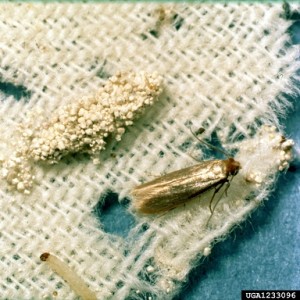Tips to Protect Your Woolens From Clothes Moths
By Chris Williams on May 28, 2015.

Webbing Clothes Moth with larvae
I know it’s late but I’m finally getting around to storing my winter clothes and woolens for the summer. Since the only place I have to store them is in the attic, I’m worried about clothes moths getting into the boxes. Is there anything I can do to protect the clothes? A. F., Fitchburg, MA
Yes, there are several things you can do to protect your sweaters, blankets, and other woolens from clothes moths (and also damaging carpet beetles). Of course, the attic isn’t the best place to store woolens due to the temperature and humidity variability, but given that constraint, here are my recommendations:
First, Clean Everything
The first, and most important, step is to make sure the clothes are clean before you store them. Clothes should be dry cleaned after the last wearing. This is not just your mom talking, there’s a scientific reason for this. Fabric pests attack soiled clothing and woolens first. They get extra nutrition from the spilled food stains, urine, perspiration, etc. on soiled clothing (see Why Do Fabric Pests Prefer to Dine on Dirty Clothes?). Clean woolens are much less desirable to clothes moths.
Next, Choose the Right Storage Containers
Please don’t use cardboard boxes to store your woolens. They offer absolutely no barrier to clothes moths. You need an airtight container with a tight-fitting lid. Large zip-lock bags are a good choice, so are plastic tubs or storage bins with locking lids. If you’re going to hang your stored clothes, use a zippered garment bag. If you store woolens for longer than a season, periodically remove the items from storage and give them a brushing and airing in the sun before repacking. The longer woolens are stored, the more likely they are to be infested by clothes moths or carpet beetles.
Should You Use Mothballs or Cedar Repellents?
Mothballs or moth crystals are so often used incorrectly. Most people don’t even realize that these products are pesticides and can be dangerous. When used to protect woolens, mothballs are rarely added in sufficient amounts (read the label) to do the job. And they won’t do the job at all if the container is not airtight to contain the fumes.
Use of cedar chips or storage in a cedar chest is not very effective either, according to studies (see Does Cedar Repel Clothes Moths?). It’s the same problem. There’s no way to get a high enough concentration of the cedar oils in an enclosed space to kill the pests. When cedar does work, it only kills small clothes moth larvae, not the adult moths.
Bottom line? Forget about repellents like mothballs or cedar and concentrate instead on proper cleaning and storage. If you do find fabric pests such as clothes moths, carpet beetles, or silverfish infesting woolens, give Colonial a call. For more information, see How Can I Protect My Clothes From Clothes Moths?
Photo: Clemson University – USDA Cooperative Extension Slide Series, Bugwood.org